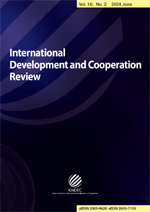학술논문
Bridging the Gap: A Study of Data Gaps and Their Causes of SDG 13 in ASEAN Countries
이용수 0
- 영문명
- 발행기관
- 국제개발협력학회
- 저자명
- 임서연(Seoyeon Lim) 류소은(Soeun Ryu) 유지은(Jieun Yoo) 조재연(Jaeyeon Jo) 고길곤(Kilkon Ko)
- 간행물 정보
- 『국제개발협력연구』제17권 제3호, 1~22쪽, 전체 22쪽
- 주제분류
- 사회과학 > 정책학
- 파일형태
- 발행일자
- 2025.09.30
5,440원
구매일시로부터 72시간 이내에 다운로드 가능합니다.
이 학술논문 정보는 (주)교보문고와 각 발행기관 사이에 저작물 이용 계약이 체결된 것으로, 교보문고를 통해 제공되고 있습니다.

국문 초록
연구목적: 본 연구는 ASEAN 10개국을 대상으로 SDG 13(기후변화 대응)의 세부지표별·국가별 결측 양상을분석하고, 결측이 발생하는 구조적 원인을 규명하는 것을 목적으로 한다.
연구의 중요성: 기후위기의 심화로 인해 SDG 13의 이행 수준을 정확히 진단하는 것은 효과적인 정책 수립과국제 협력의 필수 조건이 되었다. 그러나 ASEAN 지역은 구조적·제도적 한계로 인해 SDG 13 지표의 결측률이높아, 정책 판단과 자원 배분에 왜곡을 초래할 수 있으며, 이로 인해 정책적 활용에도 제약이 따르고 있다.
연구방법론: 이에 본 연구는 설명적 순차 설계(Explanatory Sequential Design)를 적용하여, ASEAN 10개국의SDG 13 하위 지표(13.1.1, 13.1.2, 13.1.3, 13.2.2, 13.3.1)에 대한 2015~2024년간의 결측률을 정량적으로 분석하고, 이를 기반으로 결측의 구조적 요인을 질적으로 해석하였다. 기술 통계 및 히트맵 시각화를 통해 결측의 시공간적분포를 파악하고, 주요 정책 문서 분석을 통해 제도적·정책적 맥락 속에서 결측 원인을 다층적으로 도출하였다.
연구결과: 연구 결과, ASEAN 10개국의 SDG 13 데이터는 모든 하위 지표에서 전반적으로 높은 결측률을 보였으며, 지표별로는 13.3.1(96.25%), 13.2.2(76%), 13.1.2(71%), 13.1.3(68.33%), 13.1.1(59.4%) 순으로 확인되었다. 국 가별로는 라오스, 브루나이, 싱가포르 등 일부 국가에서 결측률이 90%를 상회한 반면, 필리핀과 말레이시아는 비교적 낮은 수준인 40~50%대를 기록하였다. 이어서 수행한 질적 분석을 통해, SDG 13 데이터 결측의 주요 요인은 국가 수준(정책적 우선순위, 통계 인프라, 재정 역량), 지표 수준(측정 방식의 불명확성, 국가-국제 지표 간의 구조적 불일치), 그리고 거버넌스 수준(국제기구 간 협력 부족, UN 데이터 수집 및 보고 체계의 한계)에서 복합적으로 작용하는 것으로 나타났다.
결론 및 시사점: SDG 13 데이터 결측 문제는 단순한 통계 누락을 넘어, 제도적·정치적 요인이 복합적으로 작용한 결과로 해석될 수 있다. 이에 따라 지표 설계 단계에서의 개념적 명확성과 국가 맥락에 맞는 현지화가 요구된다. 또한, 국가 통계역량 강화를 위한 기술 협력, 국제 보고체계 내 조정 기능 개선, 정책과 지표 간 연계성 제고를 위한 다층적 접근이 필요하다. 향후 SDG 13 데이터 결측을 해소하기 위해서는 데이터 기반의 정책 수립과 이를 뒷받침하는 제도적 지원이 병행되어야 한다.
영문 초록
Purpose: This study aims to analyze the missing data patterns of SDG 13 (Climate Action) indicators across ASEAN countries and to identify the structural factors contributing to such gaps.
Originality: As the climate crisis intensifies, accurately assessing SDG 13 im- plementation is vital for effective policymaking and international cooperation. However, in ASEAN, structural and institutional limitations have resulted in high missing data rates, undermining the indicators’ policy relevance and utility.
Methodology: To address this issue, the study uses an explanatory sequential design, first analyzing missing rates for five SDG 13 sub-indicators (13.1.1, 13.1.2, 13.1.3, 13.2.2, 13.3.1) from 2015-2024 across ten ASEAN countries, then qualitatively exploring structural causes. Descriptive statistics, heatmaps, and policy document analysis were used to examine spatiotemporal patterns and institutional contexts.
Result: The results reveal that all five sub-indicators of SDG 13 show high missing rates, with 13.3.1 (96.25%), 13.2.2 (76%), 13.1.2 (71%), 13.1.3 (68.33%), and 13.1.1 (59.4%) in descending order. At the country level, Laos, Brunei, and Singapore recorded missing rates exceeding 90%, whereas the Philippines and Malaysia showed relatively lower rates of 40-50%. Qualitative analysis further identified the major causes of missing data at three levels: Government Will and Strategy (Policy Priority, National Data Collection and Monitoring Systems, and Financial Capacity), Variability of Indicators (Ambiguity in SDG Indicator Concepts and Measurements, and Differences Between Global Indicators and Localized SDG Indicators), and Data Governance System (UN Data Collection and Reporting System, and International Coordination Mechanisms).
Conclusions and Implication: These findings suggest that missing data in SDG 13 is due to complex institutional and political dynamics, rather than soley technical issues. Thus, conceptual clarity and contextual adaptation in indicator design are essential. A multi-level approach is needed—strengthening statistical capacities, improving international coordination, and aligning policy goals with indicator frameworks. Closing data gaps requires advancing both data-informed policymaking and institutional support systems.
목차
I. Introduction
II. Literature Review
III. Method
IV. Status and Character of Missing Data in SDG 13 Indicators
V. Factors Infl uencing Missing Data in SDG 13 Indicators
VI. Discussion and Conclusion
References
해당간행물 수록 논문
- 국제개발협력연구 제17권 제3호 목차
- Bridging the Gap: A Study of Data Gaps and Their Causes of SDG 13 in ASEAN Countries
- Evaluating the Additionality and Development Impact of Blended Finance in Latin American - Energy Sector: A Quasi-Experimental Approach
- 분쟁지역 스타트업 보조금 지원 ODA 사업의 효과성에 대한 실증 연구: 팔레스타인 사례를 중심으로
- In-depth Gender Analysis of Factors Contributing to Out-of-School Girls: Evidence from Nepal
- 르완다 여성 가장 극빈곤가구 자활프로그램의 효과 및 영향요인에 관한 연구: KOICA 르완다 Ultra-Poor Graduation 사업에서 코치 신뢰의 효과와 영향 요인을 중심으로
- Does Water Governance Significantly Affect the Effectiveness of Development Aid on Access to Drinking Water: Insights from Low-Income Countries with a Focus on Sub-Saharan Africa
- ODA인프라에 대한 인식이 수원국 주민들의 지역개발 기대심리에 미치는 영향 분석: 필리핀 팡일만 교량사업 사례를 중심으로
참고문헌
관련논문
사회과학 > 정책학분야 BEST
- 공유경제의 전망과 과제에 관한 탐색적 연구
- 한국 난민정책의 문제점과 개선방안
- South Korea’s Strategic Role in Global Health: Promoting Multilateral Cooperation, Health Equality, and Disease Eradication
사회과학 > 정책학분야 NEW
- 국제개발협력연구 제17권 제3호 목차
- Bridging the Gap: A Study of Data Gaps and Their Causes of SDG 13 in ASEAN Countries
- Evaluating the Additionality and Development Impact of Blended Finance in Latin American - Energy Sector: A Quasi-Experimental Approach
최근 이용한 논문
교보eBook 첫 방문을 환영 합니다!

신규가입 혜택 지급이 완료 되었습니다.
바로 사용 가능한 교보e캐시 1,000원 (유효기간 7일)
지금 바로 교보eBook의 다양한 콘텐츠를 이용해 보세요!



